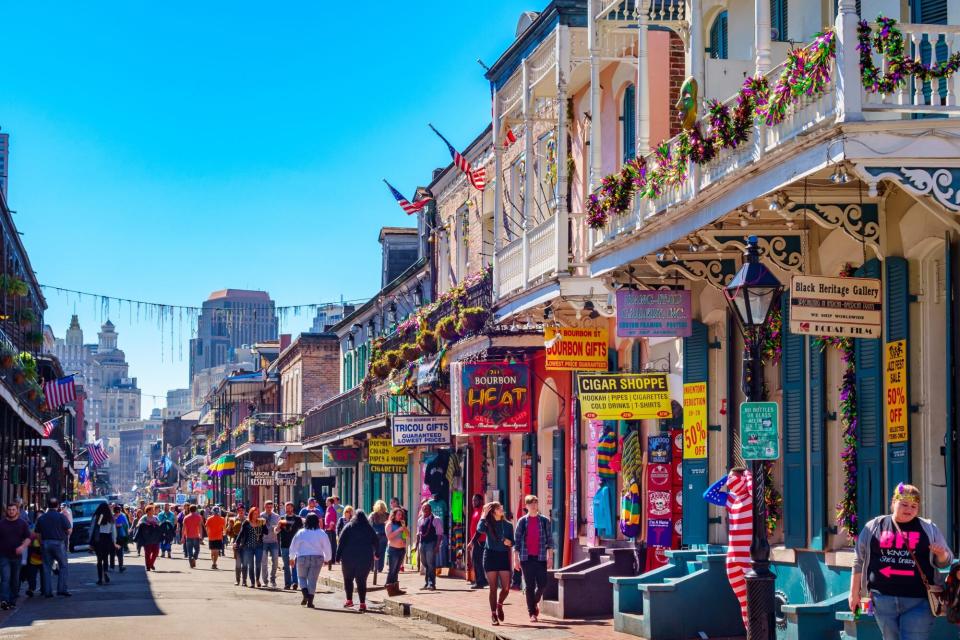A History of Mardi Gras—Plus, How New Orleans Became the Place to Celebrate
Today, revelers know Mardi Gras as the bead-throwing, mask-wearing, parade-going party that overtakes the streets of New Orleans in the weeks before Fat Tuesday. But long before it was a staple in Southern culture, Mardi Gras was celebrated for centuries across medieval Europe. Mardi Gras traveled in the 17th and 18th centuries from Rome to Venice and, later, to France. It was celebrated each year on Fat Tuesday, the day before Ash Wednesday, or the beginning of Lent on the Roman Catholic calendar. "It was celebrated then for the same reason it's celebrated now: because we love to party," Arthur Hardy, author and publisher of The Annual Mardi Guide and Magazine, explains. Of course, "initially, there was greater religious significance. The Catholic Church established the dates in relation to Easter and Lent. It's the feast before the fast."
The celebration hit the U.S. in 1699, according to Liz Williams, founder of the Southern Food & Beverage Museum, when Pierre Le Moyne, Sieur d'Iberville, reached the Gulf of Mexico south of New Orleans, on the day before Fat Tuesday and named the land Pont du Mardi Gras. It was there that the first U.S. Mardi Gras celebration was ever recorded, Williams says. But it wasn't until February 24, 1857 that the first organized parade was held in New Orleans, Hardy says. "It was a single parade with two floats," he says. "Now, we have about 60 parades with 11,000 floats."
The holiday even has its own official color scheme—purple, gold, and green—which you'll find on king cakes, clothes, beads, and more during the event. The accepted history of these Mardi Gras colors dates to the first Rex parade, in 1872, which had a "Symbolism of Colors" theme, identifying purple with justice, green with faith, and gold with power—and creating a three-color palette mimicking royal flags of the time. The official Mardi Gras website also offers a suggestion as to how the three shades influenced the school colors for Louisiana State University and Tulane University: "They say when LSU was deciding on its colors, the shops in New Orleans had stocked up on purple, green, and gold for the Mardi Gras season," it reads. "LSU decided upon purple and gold, and bought much of it. Tulane bought much of the only remaining color—green."

benedek / Getty Images
And that's just New Orleans and the greater Louisiana area—Mobile, Alabama, has a claim to Mardi Gras, too. "Mobile claims to have celebrated the first Mardi Gras in the U.S.," explains Williams. "The people in the French settlement of Mobile celebrated Mardi Gras in 1703 at 27 Mile Bluff." In 1711, Mobile's Boeuf Gras Society wheeled the head of a bull through the city's streets, which Mobile claims is the first Mardi Gras parade in the U.S., not the one later held in New Orleans.
In both places, and especially New Orleans, pre-Lenten balls and fêtes flourished in the 1700s, says Hardy. By the 1900s, Mardi Gras became more public and organized, and parades were introduced to the revelry. Today, Mardi Gras balls still exist, but parades and simple revelry in the streets has taken over. "Today in both Mobile and New Orleans, it is more formalized with organizations planning marching through the streets, floats, and costuming," Williams says.
Regardless of Mobile's claim to Mardi Gras, New Orleans is the place to celebrate. Williams explains that "New Orleans was an important city in the U.S. because of the Port of New Orleans and the Mississippi River," which allowed its Mardi Gras celebrations to grow and grow. "And since the city was predominantly Roman Catholic, the custom of feasting before Lent was understood by all of the citizenry," Williams points out. "Finally, through its growth, the season attracted tourists and lots of attention, causing it to become well known all over the country."

